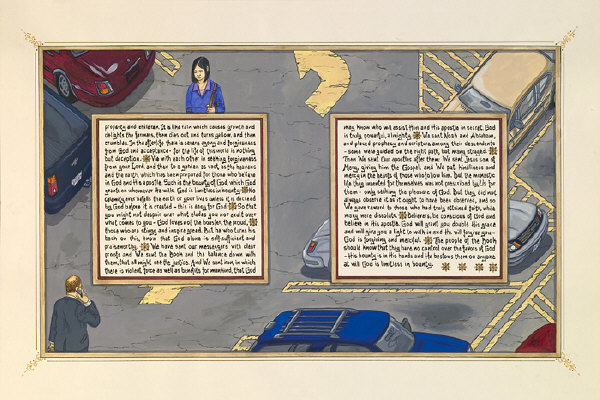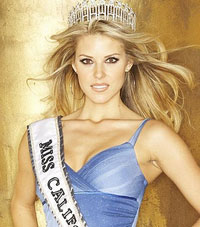 Can the Qur’an, a book that is indelibly, even necessarily, Arabic, have a place in American culture? Sandow Birk, a “vaguely Presbyterian” American artist from Southern California presents that question in “American Qur’an.” In an exhibit of works on paper opening this week at a gallery in San Francisco, Birk juxtaposes passages from the Islamic Scriptures (in English, lettered in Los Angeles’s “Cholo” graffiti style) with scenes drawn from American life, including 9/11 and a NASCAR racetrack. While he told The New York Times that his intentions are “respectful and reverential,” Birks admits that “I’ve been more hesitant and self-doubting about this project than anything else I’ve ever done.”
Can the Qur’an, a book that is indelibly, even necessarily, Arabic, have a place in American culture? Sandow Birk, a “vaguely Presbyterian” American artist from Southern California presents that question in “American Qur’an.” In an exhibit of works on paper opening this week at a gallery in San Francisco, Birk juxtaposes passages from the Islamic Scriptures (in English, lettered in Los Angeles’s “Cholo” graffiti style) with scenes drawn from American life, including 9/11 and a NASCAR racetrack. While he told The New York Times that his intentions are “respectful and reverential,” Birks admits that “I’ve been more hesitant and self-doubting about this project than anything else I’ve ever done.”
Birk’s trepidation is well-placed. In 2006, Muslims around the world reacted bitterly and sometimes violently to cartooned portrayals of the Prophet Muhammad in a Danish newspaper. The protestors were reacting to what they considered disrespect shown to the founder of Islam, but Islamic tradition takes a dim view of figurative artwork in general: merely mixing image and Scripture might be taken as a provocation. By blatantly connecting the Twin Towers disaster and Islam’s holy book, Birk almost guarantees that “American Qur’an” will be.
A surfer who has made several trips to Muslim countries in search of good waves, Birk says his series comes out of a well-grounded curiosity about the Qur’an. (And for the record, he believes, according to the Times, that 9/11 was “the work of ‘fanatics with their own agendas and not representative of an entire, global religion.”) Recognizing that the Qur’an in English would not, technically, “even be considered a Qur’an by Islamic scholars, Birk calls his depictions “personal meditations.”
While Muslims might feel Birk treads a bit heavily on their sensitivities, they might also see in the exhibit a positive trend in how non-Muslim Americans are approaching the Qur’an, which can seem forbiddingly foreign to Westerners. Some religion scholars have begun urging Western readers to tackle the Suras not as cryptic messages to be decoded solely by Islamic tradition, but as spiritual writing that invites us to interpret it, with our usual reading skills of reason and experience.
Birk’s “personal meditations” seem to fit into this generous (and typically American) method of exegesis. By contemplating the Qur’an in terms of American iconography and life, Birk may not be creating an American Qur’an but could be part of making a place in America for the Qur’an to live and be understood.


